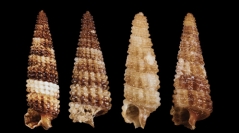

 Zoosystema
46 (18) - Pages 457-503
Zoosystema
46 (18) - Pages 457-503This study aims to evaluate the taxonomic composition of triphorids from Martinique obtained by the MADIBENTHOS expedition, which comprised more than 500 marine sampling events. In addition, some identifications of shallow-water triphorids from Guadeloupe (based on recent works) are corrected. After the analysis of 1615 specimens, 33 triphorid species were found in the shallow waters of Martinique, of which Inella spinosa n. sp., Isotriphora pardus n. sp. and Metaxia discus n. sp. are described as new species. New records are given for the Lesser Antilles, such as Cheirodonta dupliniana (Olsson, 1916), Strobiligera inaudita (Rolán & Lee, 2008) and Triphora martii Rolán & Fernández-Garcés, 1995. The taxonomy of some species is discussed (mainly on Nanaphora Laseron, 1958), and new generic allocations are proposed: Marshallora abacoensis (Rolán & Redfern, 2008) n. comb., Marshallora armandoi (Espinosa & Ortea, 2020) n. comb., Marshallora grenadensis (Rolán & Lee, 2008) n. comb., Marshallora monteiroi (Rolán & Fernández-Garcés, 2015) n. comb. The individual rarefaction curve of triphorids from MADIBENTHOS is nearly saturated but did not reach the asymptote. Seven species (all with planktotrophic development) were considered abundant or much abundant, whereas eight species (with planktotrophic or non-planktotrophic development) were represented by singletons or doubletons. Brushing and suction were efficient methods to obtain triphorids, and some dredging events recovered up to 13 species (mainly deeper than 50 m). More species were sampled in the Atlantic side of Martinique, but hyper-diverse stations were widespread along the island. The abundance of triphorids and species composition change in Martinique along the depth gradient; Iniforis turristhomae (Holten, 1802) is the most abundant triphorid between 0-30 m, but Cosmotriphora melanura (C.B. Adams, 1850) predominates between 31-85 m.
Biodiversity, Lesser Antilles, larval development, depth zones, new combinations, new species